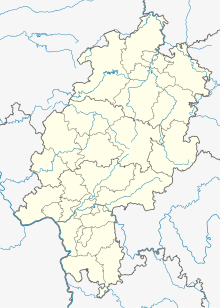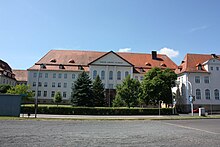Oflag IX A / Z
Coordinates: 51 ° 0 '4 " N , 9 ° 42' 58" O
Oflag IX A / Z was a Wehrmacht prison camp set up in Rotenburg an der Fulda in Northern Hesse for up to 600 Allied officers during World War II . From December 1, 1939 to June 1940, over 400 Polish officers were initially housed there, then by the beginning of August 1942 almost 600 Belgian officers. From the end of August 1942 there were about 600 officers from Great Britain and the Commonwealth , and from March to June 1943 about 150 officers from the USA .
history
At the end of August 1939, just before the German invasion of Poland , a military hospital was set up in the building of the Jakob Grimm School in Rotenburg . However, this was reversed a few weeks later, and instead, from December 1, 1939, the building served as a prison camp for more than 400 Polish officers and 56 Polish military priests. The 56 clergymen were taken to Buchenwald concentration camp on April 18, 1940 and from there to Dachau concentration camp on July 7, 1942 , where about a third of them perished violently, often as victims of pseudo-medical experiments . From June 26, 1940, the officers were brought to the Stalag II C or the Oflag II C in Woldenberg in the Neumark , as they needed space in Rotenburg for Belgian officers captured during the attack on the Benelux countries .
At the end of June 1940 around 600 Belgian officers were brought to Rotenburg. Except for a few prematurely released, they spent the next two years in Rotenburg before they were relocated to Fischbek (near Hamburg) at the end of July / beginning of August 1942 . Instead of them, British officers , from 1943 also Australian and New Zealand officers, and from March to June 1943 also about 150 American officers came to the camp, which was named OFLAG IX A / Z at the end of August 1942.
In order to break the monotony of everyday life in the camp and to be physically and mentally active, the inmates organized numerous activities. Gardening, sports, music, painting and theater were popular, but academic training also took up a lot of space. Among the captured reserve officers there were a number of academics who offered courses and were authorized to take examinations. The International Committee of the Red Cross took care of the teaching material and the transfer of examinations to British universities . The dining room was available as a study and reading room outside of the meals eaten together, and next to it a smaller room was set up as a permanent study. In April 1945, the stock library held more than 5,000 volumes; After the end of the war, they were disposed of together with the barbed wire barn in the camp in a huge pit that was created by a landslide above the school grounds in 1934.
Known inmates
The later MP in the British House of Commons and Minister for Aviation Frederick Corfield acquired his training as a lawyer during his imprisonment in Rotenburg. One of the lecturers in the camp was the lawyer Charles Hamson , who returned to Cambridge University after the war and became professor of international and comparative law there. The actor Desmond Llewelyn , best known for his role as Q in 17 James Bond films, who was imprisoned in northern France as a lieutenant in the Royal Welch Fusiliers in May 1940, was an inmate in the camp for almost five years. The British brigadier Claude Nicholson , who was taken prisoner in May 1940 as Commander of Calais , was also held prisoner in Oflag IX A / Z. Peter Conder , who was captured in France in June 1940, came to Rotenburg in July 1943 and continued his studies of the local bird life that he had already begun in the Oflags VB in Biberach , VI B in Dössel and VII B in Eichstätt ; he was 1963-1976 director of the Royal Society for the Protection of Birds .
The End
On March 29, 1945, when American troops approached, the camp was evacuated by its guards, and the prisoners were driven on foot marches through Thuringia in a northeastern direction. The last bivouac was in the meadows around the former Wimmelburg monastery , on the road from Sangerhausen to Eisleben . There the guards separated from the prisoners. On April 13, 1945, they met soldiers from the 3rd Amored Division of the US Army .
Individual evidence
- ↑ John H. van Vliet, Jr .: The Select Committee on the Katyn Forest Massacre (The Madden Committee) , February 4, 1952, Washington, DC ( Memento of the original of September 23, 2015 in the Internet Archive ) Info: The archive link was inserted automatically and not yet tested. Please check the original and archive link according to the instructions and then remove this notice.
- ^ Wimmelburg chapel - Photograph taken by Lee Hill (accessed December 23, 2013)
literature
- Lieutenant-Général Crahay: Une vie au XX ° siècle , Bruxelles 1988, pp. 93-97.
- Peter Green: The March East 1945: The Final Days of Oflag IX A / H and IX A / Z , The History Press, 2011

